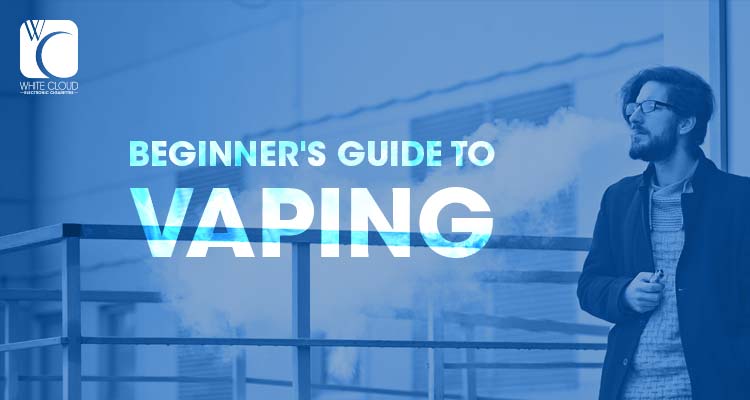Vape shops have been popping up in cities across the US for the last few years, but the technology behind e-cigarettes has been around for decades. If you’re new to e cigarettes and want to learn more about how vaping works, you’ll find a wealth of information here on White Cloud’s blog. This series will focus on the history of e-cigarette technology, scientific research, vaping laws, and anything else you need to know when taking the first step into the world of vaping.
What is Vaping?

Vaping involves using a device that heats liquids to produce vapor, which the user then inhales and exhales in a fashion that mimics smoking. According to Public Health England, vaping is safer than smoking by 95 percent. Consequently, many people have taken up vaping to help them quit smoking. The liquids used for vaping, usually called e-liquids or e-juices, are mixtures of vegetable oils and artificial flavorings. Some contain nicotine while others do not.
The History of Vaping
Although the electronic cigarette still seems like a relatively new technology, the idea dates as far back as 1927, when Joseph Robinson filed for a patent, which was granted in 1930. Nothing ever came about after the patent was granted and it is unclear whether or not a prototype was ever created.
Serious research into the technology began in the 1960s when Herbert A. Gilbert was granted a patent for a device that closely resembles the modern e-cig devices we see today. Although Gilbert did create prototypes for his device, they were never commercialized.
By the late 70s into the 80s, a pioneer of computers and his personal physician began developing a variation of the electronic cigarette, which did reach major retailers; however, the device was faulty and did not prove to be a promising technology for nicotine delivery. Although the device didn’t take off, the inventors are credited with contributing the word “vape” as a verb to describe the act of inhaling vapor.
By the 1990s, several patents for nicotine inhalers were filed, including the first “heat-not-burn” device developed by RJ Reynolds. This is also when the commercialization of more products resembling modern e cigarettes took place. In 1998, the FDA denied a request from a major US tobacco company to allow a variation of an e-cig to enter the market, as the FDA looked at it as an unapproved drug delivery device.
The first commercial e-cig was developed in 2003 by Hon Lik, a Chinese pharmacist whose father, a heavy smoker, had recently died of lung cancer. As a heavy smoker himself, Lik’s goal was to create a device to help wean people off of tobacco cigarettes. E cigs remained a niche market in Asia for a few years before becoming available in Europe and the US between 2006 and 2007.
Vaping Laws and Regulations

As vaping became more popular, governments and health organizations around the world started to take notice of the growing industry. In 2008, Turkey became the first country to ban the sale of e cigs, claiming they were just as harmful as tobacco cigarettes and that “nicotine is the most dangerous element among 4,800 poisonous chemicals in cigarettes.”
By the end of 2008, the World Health Organization (WHO) announced its stance on e cigs, claiming that electronic cigarettes were not a legitimate smoking cessation aid and demanded vape companies remove any language suggesting e cigs were a safe and effective way to quit smoking. This is also when a study out of New Zealand concluded that e cigarettes were far less dangerous than tobacco cigarettes and nicotine delivery was comparable to nicotine inhalers.
By 2009, other countries began banning the importation of e cigarettes, including Australia and Jordan. In the US, the FDA began blocking e-cig shipments from abroad despite lacking the legal authority to do so. The FDA’s interference with e-cig shipments resulted in a long lawsuit that ended in favor of one of the first US-based e-cig companies and marked the beginning of the FDA’s attempts to claim authority over e cigarettes based on the Tobacco Control Act of 2009.
That same year, state and local governments in the US began passing laws to regulate vaping. In response, consumer advocacy groups, such as CASAA, began forming to push for more sensible vaping regulations.
Misinformation About Vaping Begins

The backlash against e-cigarettes was, and still is, fueled by misinformation about vaping, some of which is intentionally spread by health organizations and anti-smoking campaigns. Throughout the last decade, sensational media misrepresentations of scientific studies have skewed public opinion and left most people ignorant of the real research surrounding vaping.
Since vaping looks like smoking, it’s natural for many non-smokers to have a visceral reaction to e-cigs; however, if you read the thousands of pages of medical research on the topic, it’s impossible to conclude that vaping is just as dangerous as smoking tobacco. Unfortunately, public health officials often make decisions based on politics rather than science, so they sometimes throw out the baby with the bath water by trying to ban e-cigarette use altogether.
The FDA has become increasingly draconian with its classification of e-cigs as tobacco products as of 2016, despite years of research pointing towards e-cigs as a safer alternative to tobacco. Consequently, e-cigs and vaping will soon be subject to the same rules that govern tobacco and smoking. Additionally, the FDA is requiring manufacturers to apply for pre-market approval for every product they make, a process that most e-cigarette companies simply can’t afford and will result in the decimation of 99 percent of the industry if the FDA’s vaping regulations remain unchanged.
Related: Politicians Fight to Save the US Vaping Industry
Meanwhile, governments in other countries like the UK and New Zealand are actually promoting vaping for tobacco harm reduction by encouraging smokers to make the switch. The word “vape” was even named Oxford Dictionaries’ International Word of the Year in 2014, and received an entry in the Oxford English Dictionary the following year.
The Future of Electronic Cigarettes
Today, there are hundreds of vaping devices and thousands of e-liquids to suit any vaper’s preferences. If you can’t find a device you like, you can even build your own. Despite herculean efforts by various world governments to stifle the availability of e cigarettes, the number of vapers keeps growing every year while smoking statistics continue to plummet, resulting in a huge consumer-driven industry with its own language.
Newcomers to the e-cig scene are often overwhelmed by vaping terms like “cig-a-like” and “mod,” so the next part of this series covers vaping terminology.






